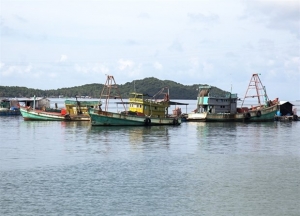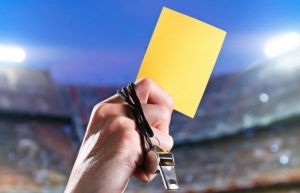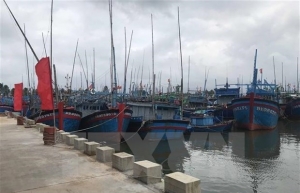Localities urged to rectify flaws in fishery sector
A delegation of the European Commission (EC) will come to Vietnam on October 20-28 to examine remedies for the yellow card that was issued following alleged illegal, unreported, and unregulated (IUU) fishing.
 |
| The European Commission will be looking for updates on the professionalism of Vietnam’s fishing sector. Photo: Duc Thanh |
Vietnam’s 28 coastal provinces and cities are undergoing major upgrades to overcome the EC’s yellow card through Decision No.1077/QD-TTg on preventing and combating IUU by 2025, which was issued by the prime minister on September 14.
The project aims to remove the yellow card, manage fishing activities, and protect seafood resources sustainably, responsible, and in the spirit of global integration.
The country has been warned for not complying with the regulations since 2017, with all seafood exported to the EU being controlled thoroughly instead of just being occasionally checked.
Vietnam is aiming to remove the yellow card as soon as possible with a series of institutional changes, including amendments to the Law on Fisheries 2017.
The law concretised regulations on the management of fishery traceability to strictly control the supply chain. For instance, vessels must notify two hours in advance when the ship leaves or docks and must present complete papers and a declaration for functional checks. If all conditions are satisfied, they shall be stamped on the certification.
Vietnam has also updated and integrated regulations of export markets into the legal framework for transparent, effective, and responsible management. In particular, the traceability of aquatic products is considered one of the important contents for tracing products to manage the fisheries in a modern way in line with worldwide standards.
The situation is adding to Vietnam’s determination and resolve to form a sustainable and responsible fishery and aquaculture industry.
Although the EC has made many recommendations for Vietnam to overcome the yellow card on IUU fishing, it mainly requires changes related to the management of fishing vessels at sea and docked ones for clear seafood traceability. These are also issues for which localities and businesses have recommendations to solve as soon as possible.
According to Decision 1077 issued earlier in September, Vietnam will effectively and efficiently implement the provisions of the Law on Fisheries.
Specifically, the decision sets the goals to mark all fishing vessels and ensure the installation of cruise monitoring equipment for vessels with a length of 15m or more engaged in fishing activities; ensure that all such vessels’ documents and equipment are checked and in accordance with regulations; and inspect all aquatic products from domestic fishing when loading and unloading these through fishing ports.
Moreover, all aquatic products originating from foreign catches arriving at Vietnam’s seaports are inspected and supervised according to the Agreement on Port Country Measures of FAO-2009 and fishing vessels and fishers will be prevented from illegal fishing in foreign waters.
The solutions for the implementation of Decision 1077 include domestic tasks – which focus on communication programmes on the harmful effects of IUU fishing and seminars, professional training, and annual conferences directing the implementation of law enforcement and fishery management. They also include international tasks such as promoting communication programmes, preventing the distribution of negative and dishonest information, and cooperating with partners such as Australia, Norway, the US, and Europe to conduct training and information campaigns.
Moreover, the decision names several other tasks, such as solutions to completing the legal framework; investments and upgrades into the fishery infrastructure and organisational apparatus; and improvements to the capacity and efficiency of patrol, inspection, and control units at sea and other relevant forces; among others.
Le Hang, director of Communications at the Vietnam Association of Seafood Exporters and Producers, found that the EC’s yellow card had directly affected seafood exports to the EU and US markets, along with other potential markets.
Hang estimates that the aquaculture industry could lose over $90 million in the time to come due to indirect impacts of the current situation. In the medium term, if the current status lasts for 2-3 years, it may cause disruption to Vietnam’s seafood exports, in which fishing output would shrink by at least 30 per cent.
Vice versa, if Vietnam was to soon remedy issues related to the EC’s yellow card, “it could take advantage of the incentives in the EU-Vietnam Free Trade Agreement and rehabilitate the nation’s seafood industry,” Hang said. “The target of exporting $1.2-1.4 billion worth of seafood to the EU could then be feasible.
In the total export turnover of seafood products of Vietnam annually with $1.9-2.2 billion, the EU and the US each account for about 16-17 per cent with a value of about $350-400 million per year.
| Phung Duc Tien - Deputy Minister of Agriculture and Rural Development
Vietnam’s legal framework for combating IUU fishing is currently relatively complete, clearly demonstrating its commitment to sustainable, responsible fishery development and international integration. The efforts of the localities over the past five years have made much progress as fleet management has gradually come into order and quotes for fishing permits in the high seas, as well as inshore and offshore areas, have been allocated, along with the well-deployed tracking and monitoring system to control ships at sea. Law enforcement forces at sea have stepped up patrols to prevent many fishing vessels from violating foreign waters. Of the four recommendations of the EC to Vietnam on combating IUU, our country is doing relatively well at the stage of building and completing the legal framework. Other stages such as ending the situation of fishing vessels illegally fishing in foreign waters, fleet management, and traceability of seafood still have many points to overcome but make progress as well. Localities are urgently directing organisations, facilities, teams, and individual fishermen to overcome the shortcomings as soon as possible. Meanwhile, the coast guard, border guard, fishery control, and local police forces have stepped up inspection and handling of violations at sea and fishing ports. At the same time, information has been distributed to fishermen so that they understand the risks and harms of IUU fishing. |
| The European Union with its 27 member countries and a population of about 516 million people imports more than $160 billion of agricultural products per year, of which about 4 per cent come from Vietnam. On August 1, 2020, the EVFTA officially took effect with about 220 tax lines on aquatic products with base tax rates from 0-22 per cent. The remaining tax will be reduced in the following 3-7 years, contributing to the increasing competitiveness of Vietnam’s seafood. In 2022, Vietnam’s seafood export turnover is expected to reach $10 billion, of which the European market accounts for 12-13 per cent, equivalent to $1.2-1.3 billion. The main focus lies on the Netherlands, Germany, Belgium, Italy, and France. Vietnam’s seafood production has increased steadily over the years, from 4.9 million tonnes in 2009 to 8.7 million tonnes in 2021, of which aquaculture production accounts for 55 per cent. The most important aquaculture species in Vietnam are basa and shrimp, which often have a large export value, accounting for 55-60 per cent of the country’s total seafood production. It is forecast that the volume of seafood exported by 2025 will be equivalent to about six million tonnes. Of this, 4.7-4.8 million tonnes are produced domestically, with some raw materials imported from other countries. |
 | Kien Giang invests over 28 mln USD in fishing infrastructure The Mekong Delta province of Kien Giang invested more than 645 billion VND (28.2 million USD) in fishing infrastructure in 2020, according to its Department of Agriculture and Rural Development. |
 | Danang closes largest fishing port of Central Vietnam From 3pm July 26, operations at Tho Quang Fishing Port, the largest fishing port in the central region, will be suspended for seven days to disinfect the area and carry out pandemic prevention measures. |
 | Government vows to stamp out unregulated fishing The Vietnamese government is doing its utmost to prevent illegal, unreported, and unregulated fishing practices, helped along by moves in Europe to remove warnings on the country’s activities. |
 | Vietnam to have 184 fishing ports by 2050: draft plan Vietnam will have a total of 184 fishing ports, capable of handling approximately 3 million tonnes of fish annually, and 160 typhoon shelters for boats by 2050 under a plan drafted by the Ministry of Agriculture and Rural Development. |
What the stars mean:
★ Poor ★ ★ Promising ★★★ Good ★★★★ Very good ★★★★★ Exceptional
Related Contents
Latest News
More News
- First members of Danang International Finance Centre revealed (December 22, 2025 | 17:39)
- Securing capital and efficiency for Vietnam’s 2026-2030 growth ambitions (December 17, 2025 | 10:00)
- Driving double-digit growth through green and circular transformation in Vietnam (December 17, 2025 | 09:00)
- Vietnam bucking trend in the global M&A landscape (December 16, 2025 | 14:20)
- Vietnam’s green transition demands collective financial action (December 15, 2025 | 12:00)
- VIR workshop highlights capital and policy for sustainable development (December 15, 2025 | 11:00)
- National Assembly approves pilot mechanisms to accelerate major projects in Hanoi (December 12, 2025 | 11:29)
- Vietnam eases policy approval requirements, simplifies foreign and outbound investments (December 11, 2025 | 17:53)
- Unpacking new momentum in Vietnam’s M&A market (December 10, 2025 | 09:59)
- Forum honours outstanding M&A deals, strategies, and advisory firms (December 09, 2025 | 18:22)


 Tag:
Tag:

















 Mobile Version
Mobile Version